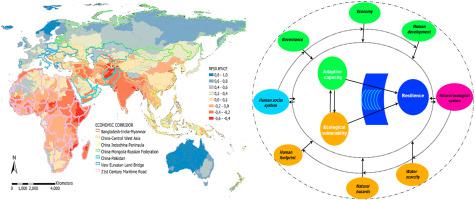Journal of Cleaner Production ( IF 11.1 ) Pub Date : 2021-05-10 , DOI: 10.1016/j.jclepro.2021.127341 Ashenafi Yohannes Battamo , Olli Varis , Peizhe Sun , Yongkui Yang , Belay Tafa Oba , Lin Zhao

|
China's Belt and Road Initiative (BRI) is a massive development plan in terms of scale and scope. It aims at facilitating China's connectivity with the rest of the world through trade, investment, and infrastructure projects. BRI encompasses seven economic corridors, which cover over 100 countries. Consequently, the spectrum of their social and ecological conditions is diverse and broad. To date, no systematic BRI scale study exists to assess the ecological challenges of these economic corridors and associate the challenges with the BRI's capacity to cope with them. Thus, it is of profound importance to understand the complex interactions between human (social-economic) and natural (ecological) systems, which are essential to design sustainable development policies in this vast region. This challenging task requires innovative and interdisciplinary research approaches in a policy relevant way. We address this gap by presenting a data-driven geospatial analysis on this complex entity using the Social-Ecological Systems approach. Methodologically, we use resilience analysis, as an equilibrium concept of Ecological Vulnerability (EV) and Adaptive Capacity (AC). A high-resolution geospatial resilience (the ability to withstand and reorganize disruptions when experiencing changes) mapping is made for the river basins along the BRI corridors to identify the drivers of resilience from 1990 to 2015. The results reveal highly diverse patterns of these drivers across the BRI economic corridors. The differences among the corridors grew within the study period. The root cause for the low resilience along the 21st-C Maritime Silk Road (predominantly the African continent) is low adaptive capacity, whereas higher ecological vulnerability is the main reason along the Bangladesh-China-India-Myanmar, China-Pakistan, China-Central-Asia-West Asia, and China-Indochina Peninsula economic corridors. Further adaptation measures are needed to mitigate the risks related to decreased AC levels and increased EV levels. Investments under the initiative should better combine adequate physical infrastructure with improving institutional (both human talent development and efficient governance) and economic capacities to cope with the existing ecological vulnerability challenges. Finally, this study highlights that over time, AC has shown notable improvements, particularly in Asia, and in contrast to a less volatile EV. The equilibrium analysis between AC and EV offers a valuable resource for policy and decision-makers to plan and manage social-ecological resilience challenges within the seven economic corridors of the BRI, and plan adaptation and mitigation strategies.



























 京公网安备 11010802027423号
京公网安备 11010802027423号